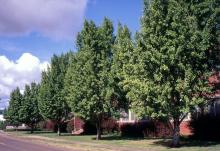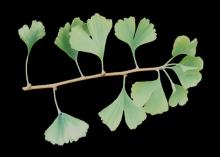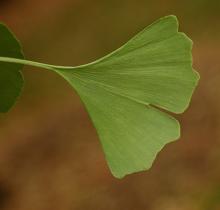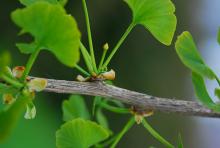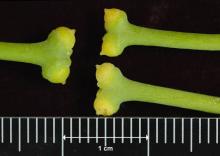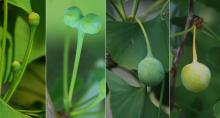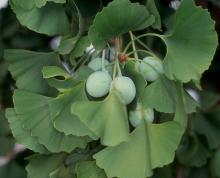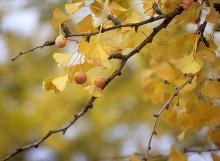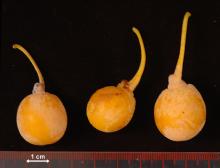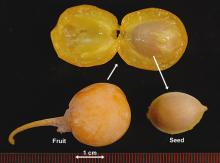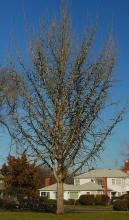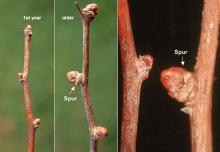Ginkgo biloba
Common name:
Ginkgo
Maidenhair Tree
Pronunciation:
GINK-go bi-LO-ba
Family:
Ginkgoaceae
Genus:
Type:
Broadleaf
Native to (or naturalized in) Oregon:
No
- Broadleaf deciduous tree, a gymnosperm, reaches 50+ ft (15+ m) tall, usually pyramidal, excurrent (dominant main leader), but variable. Leaves alternate, simple, fan-shaped, 3-7.5 cm long and wide, in clusters of 3-5 per spur or alternate on long shoots. Dioecious - male and female trees; male "flowers" (sometimes called pollen cones) are 2.5 cm long, catkin-like, with numerous stamens loosely arranged; female "flowers" are long stalked, 4-5 cm, solitary, with two opposing ovules at the end of the stalk. "Fruit" on female plants is actually not a true fruit but a naked seed (Ginkgo is a gymnosperm = gymno, naked, and sperm, seed) with a fleshy covering (the sarcotesta), it is plum-shaped (ca. 2.5 cm diam.), green then tan or orange, extremely messy and malodorous when ripe. (In their 1954 botany text, Fuller & Tippo indicate that one botanist described the fruit smell in more vernacular terms, i.e., like "raw dog vomit".) Below the fleshy sarcotesta is the hard shell (sclerotesta) of the seed and the papery endotesta which encloses the “meat” (nucellus) that surrounds the embryo. The soft seed tissues, so-called nuts, are edible and especially prized in China, Japan and Korea. However, there are food safety concerns. Sometimes fruit is set without pollination. It may be twenty or more years before a seedling flowers and sets fruit. Seedless (male) cultivars are commercially available, see below.
- Sun. Transplants easily. Prefers sandy, deep, moderately moist soil but grows in almost any situation. A durable tree for difficult landscape situations, in addition some cultivars can be espaliered or used in bonsai.
- Hardy to USDA Zone 3 Native to eastern China, long cultivated.
-
Note: Although ginkgo is considered dioecious, however, on rare occasions a branch on a male tree has been observed to produce the typical yellow plumlike structure (the so-called “fruit”) which encloses a hard seed with a viable embryo (Nagata, et al. J. Jnp. Bot. 91 Suppl. 120-127 (2016))
-
Available male selections include:
- Autumn Gold™ - broad conical habit, 40 × 30 ft (12 × 9 m), golden-yellow fall color.
- ‘Lakeview’ - compact conical form , deep gold fall color.
- ‘Magyar’ - upright braching habit, 50 × 30 ft (15 × 9 m)
- ‘Mariken’ - dwarf, some what weeping, slow growing, only 2 ft × 2 ft (0.6 m × 0.6 m) in 10 years.
- Princeton Sentry® - upright, somewhat columnar, slightly tapered from base to apex, 60 × 20 ft (18 × 6 m), yellow fall color
- Shangri-la® - uniform compact crown, dense branching, 45 × 25 ft (14 × 7.5 m), bright yellow fall color.
- Fall color is often bright yellow to gold. Trees often drop a major proportion of their fall foliage over a short period of time, sometimes during a single night. If there is little or no wind, this may result in a carpet of yellow leaves under trees.
- Ginkgo: From ginkyo, a Japanese phonetic pronunciation of the Chinese characters for "silver apricot", 銀杏, one of the Chinese names for this plant. Engelbert Kaempfer (1651-1716), a German-born physician and botanist introduced this plant to Western science under the name of ginkgo (Crane, 2013).. biloba: two lobed; leaves sometimes incised or divided, especially near shoot tips.
- Maidenhair Tree: this popular common name refers to the similarity in shape of its leaves to the leaflets of the maidenhair fern (Adiantum). Maidenhair ferns are a source of an aromatic, volatile oil commonly used as a shampoo, from which the term maidenhair is derived.
-
Silver apricot: this is a common Chinese name for Ginkgo, but according to Kirschner & Hsieh, what appears silver-colored in not the fleshy, ripe, pale yellow, outer layer of the so-called “fruit”, but the white hard seed coat (sclerotesta). Ethnobotany Research & Applications 10:321-328 (2012)
- Corvallis: northwest area of Central Park.
- Oregon State Univ. campus: east and south of Wiegand and west of Withycombe.
Click image to enlarge

